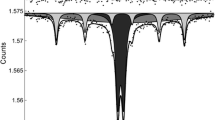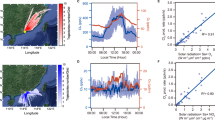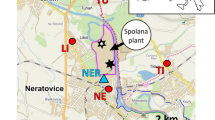Abstract
Perchlorate (ClO −4 ), a thyroid hormone disruptor, is both naturally occurring and a man-made contaminant increasingly found in a variety of terrestrial environments. The environmental presence of ClO −4 is considered to be the result of atmospheric formation and deposition processes. The ultimate processes, particularly heterogeneous-based reactions, leading to natural ClO −4 formation are not well understood. Oxidation of chlorine species by an energetic source such as lightning is considered to be one of the potential heterogeneous sources of natural ClO −4 . Currently, there is very little information available on lightning-induced ClO −4 . We designed a laboratory electrical discharge reactor capable of evaluating ClO −4 formation by the oxidation of “dry” sodium chloride (NaCl) aerosols (relative humidity (RH) <70%) in electrical discharge plasma at voltages and energies up to 24 kV and 21 kJ, respectively. Similar to other non-electrochemical ClO −4 production processes, the amount of ClO −4 produced (0.5–4.8 μg) was 3 orders of magnitude lower than the input Cl− (7.1–60.1 mg). The amount of ClO −4 generated increased with peak voltage (V) and theoretical maximum discharge energy with ΔClO −4 /ΔV = 0.28 × 10−3 μg V−1 (R 2 = 0.94) and ΔClO −4 /ΔE = 0.44 × 10−3 μg J−1 (R 2 = 0.83). The total ClO −4 generated decreased with an increase in relative humidity from 2.8 ± 0.1 μg (RH ∼46%) to 0.9 ± 0.1 μg (RH ∼62%) indicating that the presence of moisture inhibits the formation of ClO −4 . Additional modifications to the reactor support the hypothesis of ClO −4 formation due to the action of plasma on Cl− aerosols as opposed to direct oxidation on the surface of the electrodes. Finally, the contribution of lightning-induced ClO −4 in North America is calculated to have a wide range from 0.006 × 105 to 5 × 105 kg/year and is within the range of the measured ClO −4 depositional flux in precipitation samples obtained across the USA (0.09 × 105–1.2 × 105 kg/y).






Similar content being viewed by others
References
Bao, H., & Gu, B. (2004). Natural perchlorate has a unique oxygen isotope signature. Environmental Science & Technology, 38, 5073–5077.
Bing, S., Sato, M., & Clements, J. S. (2000). Oxidative processes occurring when pulsed high voltage discharge degrade phenol in aqueous solution. Environmental Science & Technology, 34, 509–513.
Dasgupta, P. K., Martinelango, P. K., Jackson, W. A., Anderson, T. A., Tian, K., Tock, R. W., et al. (2005). The origin of naturally occurring perchlorate: the role of atmospheric processes. Environmental Science & Technology, 39, 1569–1575.
Ericksen, G. E. (1981). Geology and origin of the Chilean nitrate deposits. US Geological Survey, Prof. Paper 1188, p. 37.
Furdui, V. I., & Tomassini, F. (2010). Trends and sources of perchlorate in Arctic snow. Environmental Science & Technology, 44, 558–592.
Galloway, J. M., Dentener, F. J., Capone, D. G., Boyer, E. W., Howarth, R. W., Seitzinger, S. P., et al. (2004). Nitrogen cycles: past, present and future. Biogeochemistry, 70, 153–226.
Jackson, W. A., Anandam, S. K., Anderson, T. A., Lehman, T., Rainwater, K., Rajagopalan, S., et al. (2005). Perchlorate occurrence in the Texas Southern High Plains Aquifer System. Groundwater Monitoring and Remediation, 25(1), 137–149.
Jackson, W. A., Böhlke, J. K., Gu, B., Hatzinger, P. B., & Sturchio, N. C. (2010). Isotopic composition and origin of indigenous natural perchlorate and co-occurring nitrate in the southwestern United States. Environmental Science & Technology, 44, 4869–4876.
Jaegle, L., Yung, Y. L., Toon, G. C., Sen, B., & Blavier, J. (1996). Balloon observations of organic and inorganic chlorine in the stratosphere: the role of HClO4 production on sulfate aerosols. Geophysical Research Letters, 23, 1749–1752.
Kang, N., Anderson, T. A., & Jackson, W. A. (2006). Photochemical formation of perchlorate from aqueous oxychlorine anions. Analytica Chimica Acta, 567, 48–56.
Kang, N., Jackson, W. A., Dasgupta, P. K., & Anderson, T. A. (2008). Perchlorate production by ozone oxidation of chloride in aqueous and dry systems. Science of the Total Environment, 405, 301–309.
Kang, N., Anderson, T. A., Rao, B., & Jackson, W. A. (2009). Characteristics of perchlorate formation via photodissociation of aqueous chlorite. Environmental Chemistry, 6, 53.
Kounaves, S. P., Stroble, S. T., Anderson, R. M., Moore, Q., Catling, D. R., Douglas, S., et al. (2010). Discovery of natural perchlorate in the Antarctic dry valleys and its global implications. Environmental Science & Technology, 44, 2360–2364.
Krider, E. P., & Roble, R. W. (Eds.). (1986). The earth’s electrical environment. Washington: National Academy Press.
Orris, G. J., Harvey, G. J., Tsui, D. T., Eldridge, J. E. (2003). Preliminary analyses for perchlorate in selected natural materials and their derivative products, USGS Open File Report 03–314, Washington, DC: US Government Printing Office.
Oum, K. W., Lakin, M. J., DeHaan, D. O., Brauers, T., & Finlayson-Pitts, B. J. (1998). Formation of molecular chlorine from the photolysis of ozone and aqueous sea-salt particles. Science, 279, 74–78.
Plummer, L. N., Böhlke, J. K., & Doughten, M. W. (2005). Perchlorate in Pleistocene and Holocene groundwater in North-Central New Mexico. Environmental Science & Technology, 39, 4586–4593.
Prasad, S. S., & Lee, T. J. (1994). Atmospheric chemistry of the reaction ClO + O2 ↔ ClO.O2 Where it stands, what needs to be done, and why? Journal of Geophysical Research, 99, 8225–8230.
Rajagopalan, S., Anderson, T. A., Fahlquist, L., Rainwater, K. A., Ridley, M., & Jackson, A. W. (2006). Widespread presence of naturally occurring perchlorate in high plains of Texas and New Mexico. Environmental Science & Technology, 40, 3156–3162.
Rajagopalan, S., Anderson, T., Cox, S., Harvey, G., & Cheng, Q. (2009). Perchlorate in wet deposition across North America. Environmental Science & Technology, 43, 616–622.
Rao, B., Anderson, T. A., Orris, G. J., Rainwater, K. A., Rajagopalan, S., Sandvig, R. M., et al. (2007). Widespread natural perchlorate in unsaturated zones of the Southwest United States. Environmental Science & Technology, 41, 4522–4528.
Rao, B., Anderson, T. A., Redder, A., & Jackson, W. A. (2010). Perchlorate formation by ozone oxidation of aqueous chlorine/ox-chlorine species: role of ClxOy radicals. Environmental Science & Technology, 44, 2961–2967.
Rao, B., Hatzinger, P. B., Böhlke, J. K., Sturchio, N. C., Andraski, B. J., Eckardt, F. D., et al. (2010). Natural chlorate in the environment: application of a new IC-ESI/MS/MS method with a Cl18O -3 internal standard. Environmental Science & Technology, 44, 8429–8434.
Ravishankara, A. R. (1997). Heterogeneous and multiphase chemistry in the troposphere. Science, 276, 1058–1065.
Schumann, U., & Huntrieser, H. (2007). The global lightning-induced nitrogen oxide source. Atmospheric Chemistry and Physics Discussion, 7, 2623–2818.
Simonatis, C., & Heicklen, J. (1975). Perchloric acid: a possible sink for stratospheric chlorine. Planetary and Space Science, 23, 1567–1569.
Acknowledgments
This study was supported by the Department of Defense Strategic Environmental Research and Development Program (SERDP, EP-1435). We thank the people at the Center for Pulsed Power and Power Electronics at Texas Tech University for donating the high-voltage power supply device for the lightning simulation experiments.
Author information
Authors and Affiliations
Corresponding author
Rights and permissions
About this article
Cite this article
Rao, B., Mohan, S., Neuber, A. et al. Production of Perchlorate by Laboratory Simulated Lightning Process. Water Air Soil Pollut 223, 275–287 (2012). https://doi.org/10.1007/s11270-011-0857-y
Received:
Accepted:
Published:
Issue Date:
DOI: https://doi.org/10.1007/s11270-011-0857-y




